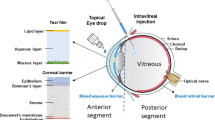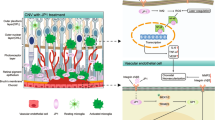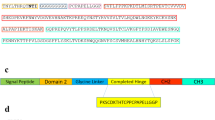Abstract
We have performed a long-term study into the use of a lipophilic amino-acid dendrimer to deliver an anti-vascular endothelial growth factor (VEGF) oligonucleotide (ODN-1) into the eyes of rats and inhibit laser-induced choroidal neovascularization (CNV). In addition, the uptake, distribution and retinal tolerance of the dendrimer plus oligonucleotide conjugates were examined. Analysis of fluorescein angiograms of laser photocoagulated eyes revealed that dendrimer plus ODN-1 significantly inhibited (P<0.05) the development of CNV for 4–6 months by up to 95% in the initial stages. Eyes similarly injected with ODN-1 alone showed no significant difference (P>0.05) in mean severity score at 2 months (2.86±0.09), 4 months (2.15±0.17) or 6 months (2.7±0.12) compared to the vehicle-injected controls. Furthermore, we showed that intravitreally injected ODN-1 tagged with 6-fam was absorbed by a wide area of the retina and penetrated all of the retinal cell layers to the retinal pigment epithelium. Ophthalmological examinations indicated that the dendrimers plus ODN-1 conjugates were well tolerated in vivo, which was later confirmed using immunohistochemistry, which showed no observable increase in antigens associated with inflammation. We conclude that the use of such dendrimers may provide a viable mechanism for the delivery of therapeutic oligonucleotides for the treatment of angiogenic eye diseases.
This is a preview of subscription content, access via your institution
Access options
Subscribe to this journal
Receive 12 print issues and online access
$259.00 per year
only $21.58 per issue
Buy this article
- Purchase on Springer Link
- Instant access to full article PDF
Prices may be subject to local taxes which are calculated during checkout







Similar content being viewed by others
References
Ohno-Matsui K et al. Novel mechanism for age-related macular degeneration: an equilibrium shift between the angiogenesis factors VEGF and PEDF. J Cell Physiol 2001; 189: 323–333.
Aiello LP et al. Vascular endothelial growth factor in ocular fluid of patients with diabetic retinopathy and other retinal disorders. N Engl J Med 1994; 331: 1480–1487.
Boulton M, Foreman D, Williams G, McLeod D . VEGF localisation in diabetic retinopathy. Br J Ophthalmol 1998; 82: 561–568.
Siemeister G, Martiny-Baron G, Marme D . The pivotal role of VEGF in tumor angiogenesis: molecular facts and therapeutic opportunities. Cancer Metast Rev 1998; 17: 241–248.
Bainbridge JW et al. Inhibition of retinal neovascularisation by gene transfer of soluble VEGF receptor sFlt-1. Gene Therapy 2002; 9: 320–326.
Lai YK et al. Potential long-term inhibition of ocular neovascularisation by recombinant adeno-associated virus-mediated secretion gene therapy. Gene Therapy 2002; 9: 804–813.
Carrasquillo KG et al. Controlled delivery of the anti-VEGF aptamer EYE001 with poly(lactic-co-glycolic)acid microspheres. Invest Ophthalmol Vis Sci 2003; 44: 290–299.
Alama A, Barbieri F, Cagnoli M, Schettini G . Antisense oligonucleotides as therapeutic agents. Pharmacol Res 1997; 36: 171–178.
Rojanasakul Y . Antisense oligonucleotide therapeutics: drug delivery and targeting. Adv Drug Deliv Rev 1996; 18: 115–131.
Urban E, Noe CR . Structural modifications of antisense oligonucleotides. Farmaco 2003; 58: 243–258.
Garrett KL, Shen WY, Rakoczy PE . In vivo use of oligonucleotides to inhibit choroidal neovascularisation in the eye. J Gene Med 2001; 3: 373–383.
Marano RJ et al. Inhibition of in vitro VEGF expression and choroidal neovascularization by synthetic dendrimer peptide mediated delivery of a sense oligonucleotide. Exp Eye Res 2004; 79: 525–535.
Wimmer N et al. Syntheses of polycationic dendrimers on lipophilic peptide core for complexation and transport of oligonucleotides. Bioorg Med Chem Lett 2002; 12: 2635–2637.
Marano RJ, Rakoczy PE . Treatments for choroidal and retinal neovascularisation of the retina: a focus on oligonucleotide therapy and their delivery, for the regulation of gene function. Clin Exp Ophthalmol 2005; 33: 81–89.
Group TES . Anti-vascular endothelial growth factor therapy for subfoveal choroidal neovascularization secondary to age-related macular degeneration: phase II study results. Ophthalmology 2003; 110: 979–986.
Tolentino MJ et al. Intravitreal injection of vascular endothelial growth factor small interfering RNA inhibits growth and leakage in a nonhuman primate, laser-induced model of choroidal neovascularization. Retina 2004; 24: 132–138.
Shen WY et al. Expression of cell adhesion molecules and vascular endothelial growth factor in experimental choroidal neovascularisation in the rat. Br J Ophthalmol 1998; 82: 1063–1071.
Stephens AC, Rivers RP . Antisense oligonucleotide therapy in cancer. Curr Opin Mol Ther 2003; 5: 118–122.
Stein CA, Cheng YC . Antisense oligonucleotides as therapeutic agents – is the bullet really magical? Science 1993; 261: 1004–1012.
Bell C et al. Oligonucleotide NX1838 inhibits VEGF165-mediated cellular responses in vitro. In vitro Cell Dev Biol Anim 1999; 35: 533–542.
Group TES . Preclinical and phase 1A clinical evaluation of an anti-VEGF pegylated aptamer (EYE001) for the treatment of exudative age-related macular degeneration. Retina 2002; 22: 143–152.
Axel DI et al. Toxicity, uptake kinetics and efficacy of new transfection reagents: increase of oligonucleotide uptake. J Vasc Res 2000; 37: 221–234; discussion 303–304..
Neerman MF, Zhang W, Parrish AR, Simanek EE . In vitro and in vivo evaluation of a melamine dendrimer as a vehicle for drug delivery. Int J Pharm 2004; 281: 129–132.
Shah DS et al. DNA transfection and transfected cell viability using amphipathic asymmetric dendrimers. Int J Pharm 2000; 208: 41–48.
Marano RJ, Rakoczy EP . Use of densitometry for evaluating severity of laser photocoagulation induced CNV: an improved method. Biotech and Histochem 2005 (in press).
Lambert V et al. Influence of plasminogen activator inhibitor type 1 on choroidal neovascularization. FASEB J 2001; 15: 1021–1027.
Schols P, Smets E . Carnoy: analysis software for LM, SEM and TEM images. 2001, Leuven: distributed by the authors, http://www.carnoy.org.
Acknowledgements
This project was funded by the NH&MRC.
Author information
Authors and Affiliations
Rights and permissions
About this article
Cite this article
Marano, R., Toth, I., Wimmer, N. et al. Dendrimer delivery of an anti-VEGF oligonucleotide into the eye: a long-term study into inhibition of laser-induced CNV, distribution, uptake and toxicity. Gene Ther 12, 1544–1550 (2005). https://doi.org/10.1038/sj.gt.3302579
Received:
Accepted:
Published:
Issue Date:
DOI: https://doi.org/10.1038/sj.gt.3302579
Keywords
This article is cited by
-
Nanomedicine and drug delivery to the retina: current status and implications for gene therapy
Naunyn-Schmiedeberg's Archives of Pharmacology (2022)
-
Use of biomaterials for sustained delivery of anti-VEGF to treat retinal diseases
Eye (2020)
-
Nanopartikel als Drug-Delivery-Systeme für die Ophthalmologie
Der Ophthalmologe (2018)



